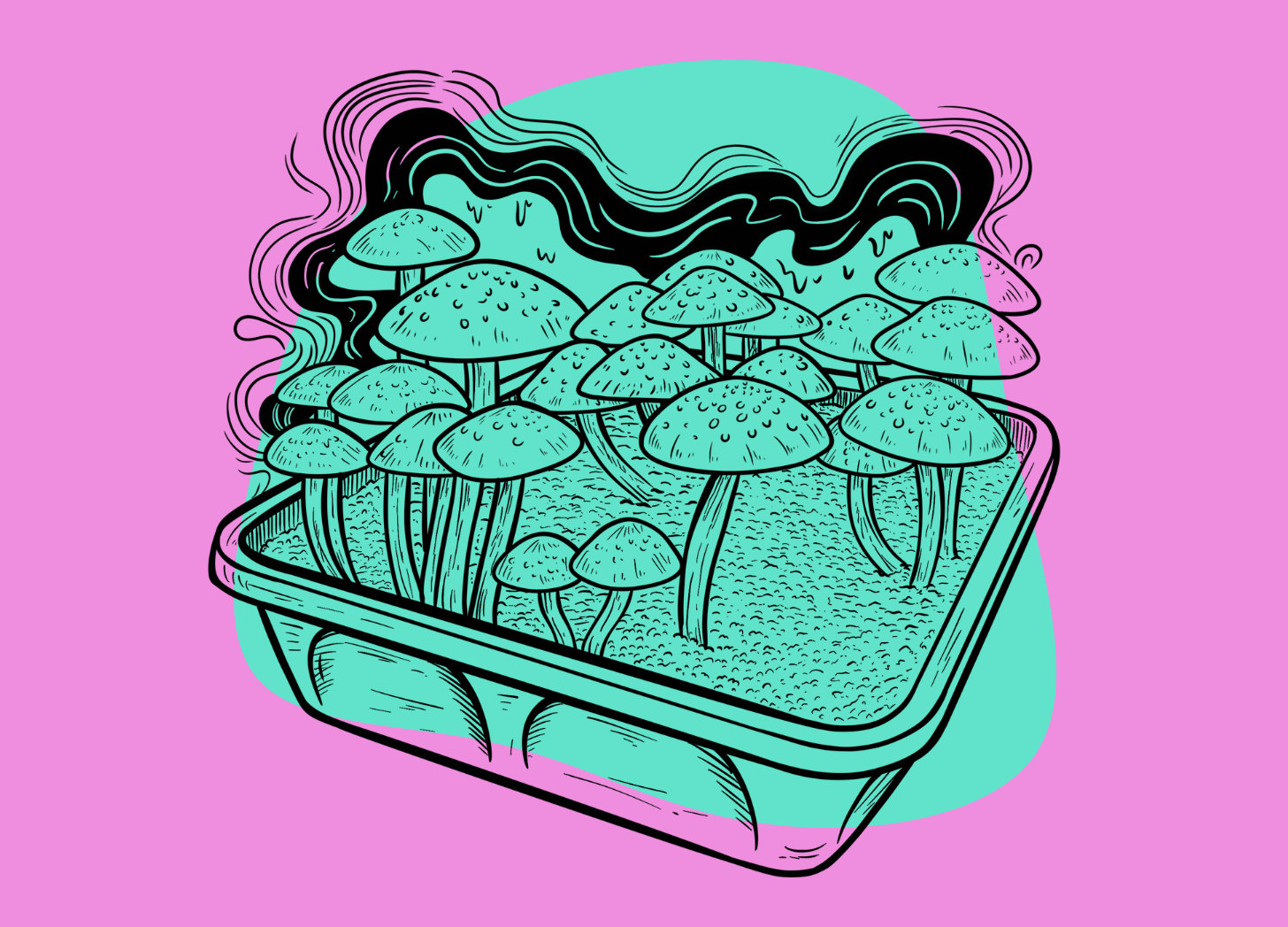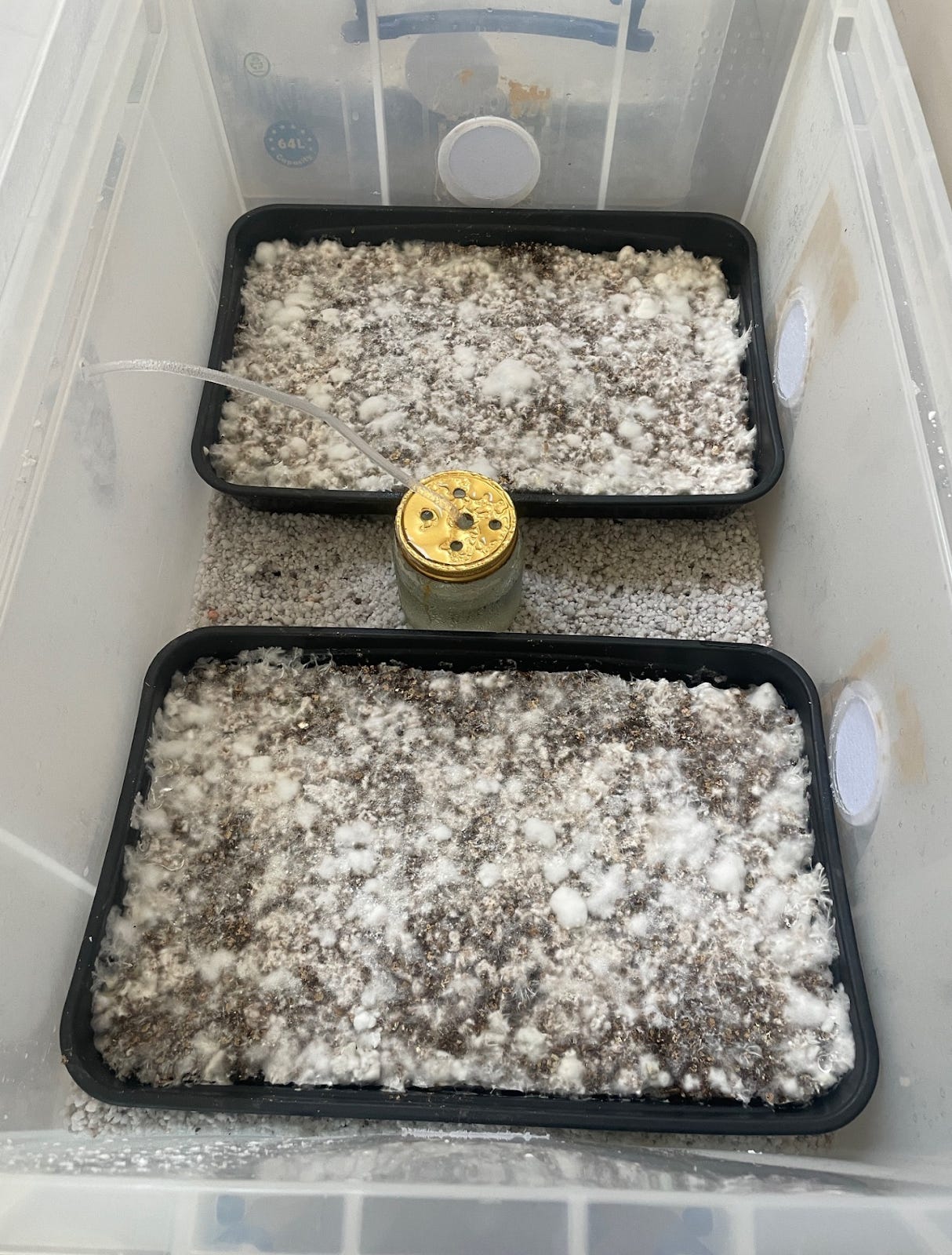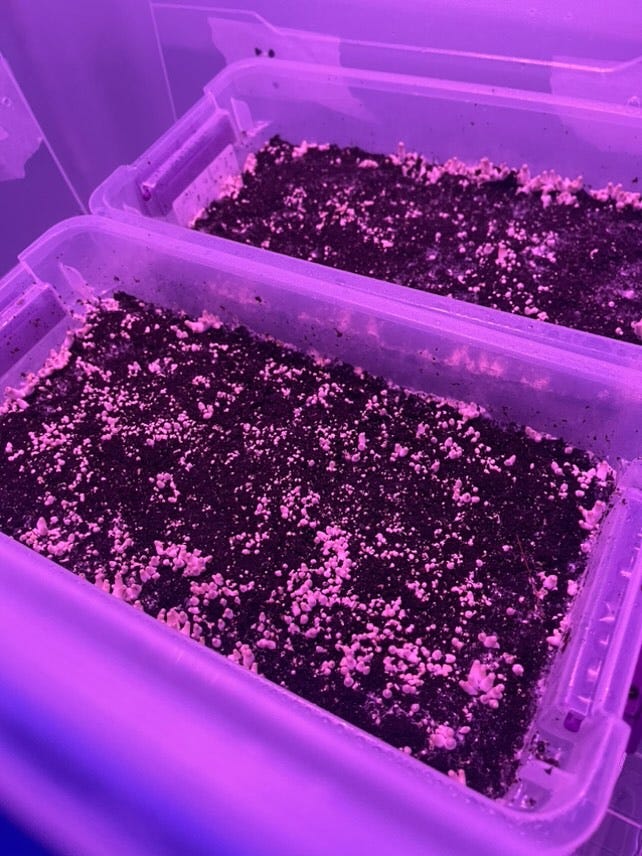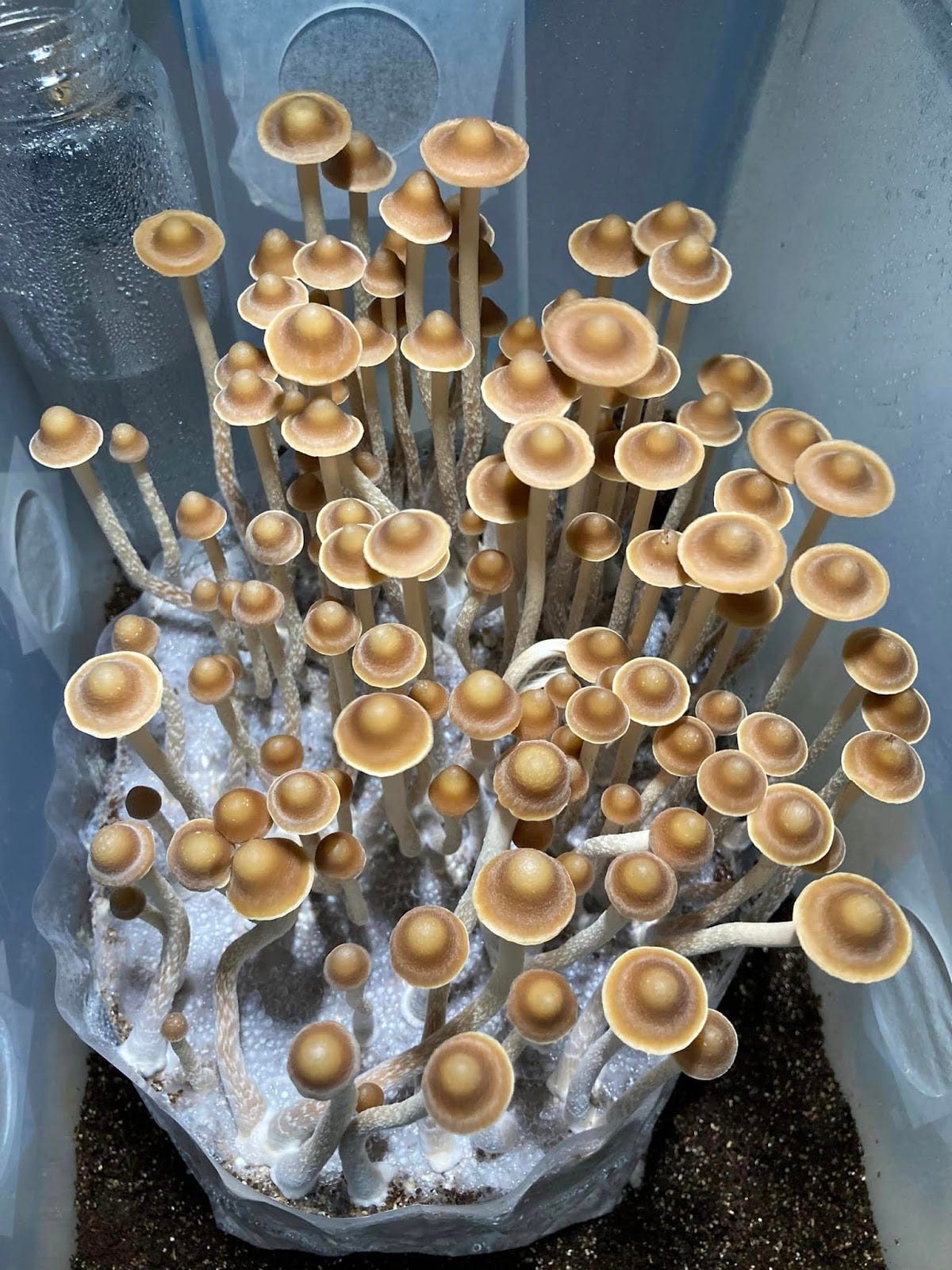Fruiting Made Easy: The Diffuser Tub Blueprint 🍄
The diffuser tub is the easiest way to fruit exotic psilocybin mushrooms at home — ridiculously simple to build & perfectly tuned for those tough exotic species.
Magic mushrooms are surprisingly easy to grow — your biggest hurdles are contamination and fruiting.
Learn to keep your grow clean and dial in the conditions, and you’ll be rewarded with more mushrooms than you know what to do with.
Today, we’re going to focus on fruiting by exploring the diffuser tub — arguably the simplest and most reliable fruiting chamber for growing exotic psilocybin species — especially the trickier ones like Panaeolus cyanescens, Psilocybe zapotecorum, or Psilocybe ingelli.
(Of course this method works great for fruiting your standard Psilocybe cubensis as well. 😉)
This post is going to be a little different than usual as we walk you through the process of setting up your own diffuser tub for as little as $100
Dial it in right, and you can start pulling in those big harvests yourself.
What is a Fruiting Chamber?
Mushroom fruiting chambers take many forms, but all share the same purpose — to create an isolated, controlled environment that gives them everything they need to thrive and produce abundant mushrooms.
These conditions will vary with species, with each having its own particular temperature, humidity, and fresh air requirements.
The type of fruiting chamber you select is dictated by the species you're growing.
Some species, such as Psilocybe cubensis, aren’t particularly fussy — and while they appreciate a humid environment, they're less sensitive to poor airflow than other species.
This is why Psilocybe cubensis is the standard choice for home-growers despite being middle of the pack in terms of actual potency.
Other species, such as Panaeolus cyanescens, Psilocybe tampanensis, and Psilocybe ingeli demand constant humidity and plenty of fresh air during fruiting. This makes them much harder to grow without special equipment.
The same can be said for several Psilocybe species long held in high shamanic regard in Mexico — P. caerulescens, P. mexicana, P. subtropicalis, and P. zapotecorum — all of which are seeing renewed interest among modern cultivators.
For all of these finicky species — as well as your standard P. cubensis — the diffuser tub delivers the right mix of humidity and fresh air, and has been proven to fruit them all (and then some).
Credit must go to cultivators Yoshi Amano of Dino Spores, Julian Mattucci of Imperial Scientific & Imperial Labs, and Gumbo Slinger for experimenting with and refining the diffuser tub fruiting chamber design.
Now let's get into the build tutorial…
The Diffuser Tub: A Smarter Monotub
The diffuser tub is a twist on the classic monotub — a simple plastic bin with holes for airflow that many growers use to fruit cubensis.
The difference is in the setup: diffuser tubs are designed to push humidity and airflow even higher — making them ideal for exotic species that struggle in standard tubs.
To get started, you'll need the following:
An aquarium pump (small pumps work just fine)
Aquarium pump tubing (the length depends on your setup, but a few feet should be more than enough)
Airstones (you can find these cheaply on Amazon or at your local pet store)
A drill & hole saw (I use 2" with filter discs, but aim for more, smaller holes if you don't have those)
A clear plastic tub (aim for something in the range of 60–75 liters)
Synthetic filter discs (totally optional, but you can buy those here)
2X Jars (optional if using the JCM Bubbler method. Opt for pint jars (16 oz/ 500mL)
Perlite (optional if using the JCM Bubbler or Shadowbox methods)
From here, you’ve got two main ways to actually build your diffuser tub:
Version 1: The Bubble-Tub
This version is the most straightforward diffuser tub design — using nothing but water and bubbles to maintain high humidity and airflow.
Add about an inch of water to the bottom of the tub and run two aquarium hoses into it, each fitted with a long airstone. Submerge the stones so they bubble constantly.
Place your fruiting trays on a rack above the waterline.
The bubbling water keeps humidity high and moves in fresh air during fruiting. Just be sure to change the water at least once a week — over time, your water will absorb CO₂ from the culture and turn slightly acidic.
(For a demo of this setup, click here.)
Version 2: The JCM Bubbler
This version replaces the plain water base with a layer of wet perlite, which retains moisture longer and combines with jars of bubbling water to maintain stable conditions.
Add two or more inches of wet perlite to the bottom of the tub.
Place two jars of water on top, each fitted with a lid drilled for an air hose and a few small “salt shaker” holes to reduce splashing. Run an aquarium pump hose into each jar with an airstone submerged.
The perlite provides steady humidity on its own, while the bubbling jars add a boost of fresh air and moisture to your tub. In some cases, the passive evaporation is enough. In others, the active bubbling makes all the difference.
Another popular variation, known as the “Shadowbox,” skips the jars entirely and runs the hoses and airstones straight into the perlite layer.
(Both P. tampanensis and P. zapotecorum have been fruited successfully with this setup.)
Tips For Success: Using Diffuser Tubs
Getting to pinning is only half the battle — what you do during fruiting decides whether your tubs stall or explode with mushrooms.
Here’s how to set yourself up for success when growing with a diffuser tub:
Keep everything sealed shut until pinning starts — Leave the lid on until pins appear after casing. Mushrooms actually like the higher CO₂ and humidity at this stage. Keeping the lid on and pump off in the early days helps boost CO₂ levels.
Turn on the air pump when pins start to form — As soon as you see pins, switch on the aquarium pump. Crack or flip the lid slightly for more airflow if needed (skip this step if you added filter-disc holes).
Use a fogger if humidity dips (optional) — Some species, like P. zapotecorum, thrive with even more humidity. Use a reptile fogger on a timer or humidity sensor so it only runs when needed.
Give them light — Mushrooms don't need much light, but they do need some. Use a dimmable aquarium light set to 8 hours on to help initiate fruiting.
Control the temperature — The ideal conditions vary slightly from one species to another, with a number of them happy at typical room temperature, but the typical range is between 20–26 ºC / 68–79 ºF. Add a submersible aquarium heater or seedling heat mat for warm-loving species (Panaeolus cyanescens) or a chiller for cold-weather species.
Add supplementary air holes — Several holes can also be drilled into the sides of the diffuser tub (with a 50mm or 2-inch hole saw cutter drill bit) over which adhesive synthetic filter discs can be placed to facilitate more passive air exchange.
Cleanliness is Next to Godliness
The key to success with any mushroom setup is cleanliness.
You want to give your mushrooms the best chance to thrive, and that means keeping contamination out. Mold, bacteria, and other competitors will happily take over if you don’t keep things spotless.
Between fruiting cycles, wash your diffuser tub with hot soapy water or spray it down with a 10% bleach solution — let it sit for ten minutes before wiping clean.
Some growers also follow up with 70% isopropyl alcohol (wipe in one direction). Just be sure to never mix alcohol and bleach together.
If you’re using the perlite version, rinse the perlite thoroughly and sterilize it in a pressure cooker, or soak it in a mild bleach or hydrogen peroxide solution. After a few runs, it’s usually just easier to replace it. I recommend adding your spent perlite to plant potting mixes or your compost.
The diffuser tub shines because it’s simple, effective, and easy to maintain.
With just a little care, it can take even the most demanding exotic species all the way to full, healthy flushes.
Good luck with your grows — and if you’ve got any questions about setting up or running a diffuser tub, drop them in the comments.
We’d love to hear how your experiments turn out!
Starting a New Grow?
SporesMD is offering Tripsitter readers 20% off all spores.
Use TRIPSITTER at checkout.
Further Reading
How to Grow Magic Mushrooms The Easy Way (Tripsitter)
Study Finds Synthetic Shrooms Aren't As Effective as the Real Deal
Mushroom Fruiting Chambers (Double Blind)
Enjoying Tripsitter? 🍄
Don’t Journey Alone! Tripsitter was built by a community of psychedelic advocates — but it’s people like you that allow us to thrive.
You can also follow us on Bluesky or subscribe to our Reddit.








